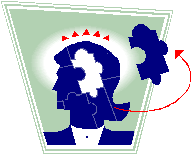 The jigsaw technique is a collaborative learning strategy that was developed in the early 1970s by Elliot Aronson, a well-known psychologist and co-author with Carol Tavris of Mistakes Were Made (But Not By Me). The jigsaw technique divides the class into groups—often of five or six students—and allows and expects each group to become the “experts” on a specific principle or dimension (i.e. puzzle section) of the larger topic (i.e. puzzle) that the class will be discussing. Each group member then becomes an even more specialized “expert” on one nuance (i.e. puzzle piece) of that specific principle or dimension. Each member of each group then reports out to the entire class (i.e. describes and places the puzzle piece). This jigsaw technique encourages individual initiative and ownership in the learning process and reduces the amount of competition among some students to be the first one to “answer” an instructor’s question, which often occurs when a question is posed to the entire class. A variation of this jigsaw technique is the “think-pair-share” technique, which was developed by Frank Lyman in the early 1980s, where two-person teams become the “experts” and then report out to the class. With the jigsaw technique, students themselves are actively providing and placing many—if not all—of the “puzzle pieces” rather than passively waiting for them to be provided and put together by the instructor.
The jigsaw technique is a collaborative learning strategy that was developed in the early 1970s by Elliot Aronson, a well-known psychologist and co-author with Carol Tavris of Mistakes Were Made (But Not By Me). The jigsaw technique divides the class into groups—often of five or six students—and allows and expects each group to become the “experts” on a specific principle or dimension (i.e. puzzle section) of the larger topic (i.e. puzzle) that the class will be discussing. Each group member then becomes an even more specialized “expert” on one nuance (i.e. puzzle piece) of that specific principle or dimension. Each member of each group then reports out to the entire class (i.e. describes and places the puzzle piece). This jigsaw technique encourages individual initiative and ownership in the learning process and reduces the amount of competition among some students to be the first one to “answer” an instructor’s question, which often occurs when a question is posed to the entire class. A variation of this jigsaw technique is the “think-pair-share” technique, which was developed by Frank Lyman in the early 1980s, where two-person teams become the “experts” and then report out to the class. With the jigsaw technique, students themselves are actively providing and placing many—if not all—of the “puzzle pieces” rather than passively waiting for them to be provided and put together by the instructor.


Thank you, Gary, for your clear explanation of some important pieces for active learning. These strategies have been successful across disciplines and age groups, and are good ‘try it’ strategies for those interested in increasing collaborative and/or cooperative learning in the classroom. Some additional suggestions for implementing collaborative/cooperative learning to help students work together and optimize their own and each other’s learning can be found here: http://www.studygs.net/cooplearn.htm